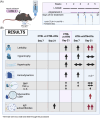Previous cardiovascular injury is a prerequisite for immune checkpoint inhibitor-associated lethal myocarditis in mice
- PMID: 38049390
- PMCID: PMC10966245
- DOI: 10.1002/ehf2.14614
Previous cardiovascular injury is a prerequisite for immune checkpoint inhibitor-associated lethal myocarditis in mice
Abstract
Aims: Immune checkpoint inhibitors (ICIs) are antineoplastic drugs designed to activate the immune system's response against cancer cells. Evidence suggests that they may lead to immune-related adverse events, particularly when combined (e.g., anti-CTLA-4 plus anti-PD-1), sometimes resulting in severe conditions such as myocarditis. We aimed to investigate whether a previously sustained cardiac injury, such as pathological remodelling due to hypertension, is a prerequisite for ICI therapy-induced myocarditis.
Methods: We evaluated the cardiotoxicity of ICIs in a hypertension (HTN) mouse model (C57BL/6). Weekly doses were administered up to day 21 after the first administration. Our analysis encompassed the following parameters: (i) survival and cardiac pathological remodelling, (ii) cardiac function assessed using pressure-volume (PV)-loops, with brain natriuretic peptide (BNP) serving as a marker of haemodynamic dysfunction and (iii) cardiac inflammation (cytokine levels, infiltration, and cardiac antigen autoantibodies).
Results: After the first administration of ICI combined therapy, the treated HTN group showed a 30% increased mortality (P = 0.0002) and earlier signs of hypertrophy and pathological remodelling compared with the untreated HTN group. BNP (P = 0.01) and TNF-α (<0.0001) increased 2.5- and 1.7-fold, respectively, in the treated group, while IL-6 (P = 0.8336) remained unchanged. Myocarditis only developed in the HTN group treated with ICIs on day 21 (score >3), characterised by T cell infiltration and increased cardiac antigen antibodies (86% showed a titre of 1:160). The control group treated with ICI was unaffected in any evaluated feature.
Conclusions: Our findings indicate that pre-existing sustained cardiac damage is a necessary condition for ICI-induced myocarditis.
Keywords: Heart damage; Heart failure; Immune checkpoint inhibitors; Inflammation; Myocarditis.
© 2023 The Authors. ESC Heart Failure published by John Wiley & Sons Ltd on behalf of European Society of Cardiology.
Conflict of interest statement
None declared.
Figures




References
-
- Rubio‐Infante N, Ramírez‐Flores YA, Castillo EC, Lozano O, García‐Rivas G, Torre‐Amione G. A systematic review of the mechanisms involved in immune checkpoint inhibitors cardiotoxicity and challenges to improve clinical safety. Front Cell Dev Biol 2022;10:851032. doi:10.3389/fcell.2022.851032 - DOI - PMC - PubMed
-
- Tay WT, Fang Y‐H, Beh ST, Liu Y‐W, Hsu L‐W, Yen C‐J, et al. Programmed cell Death‐1: Programmed cell death‐ligand 1 interaction protects human cardiomyocytes against T‐cell mediated inflammation and apoptosis response in vitro. Int J Mol Sci 2020;21:2399. doi:10.3390/ijms21072399 - DOI - PMC - PubMed
MeSH terms
Substances
Grants and funding
LinkOut - more resources
Full Text Sources
Medical

